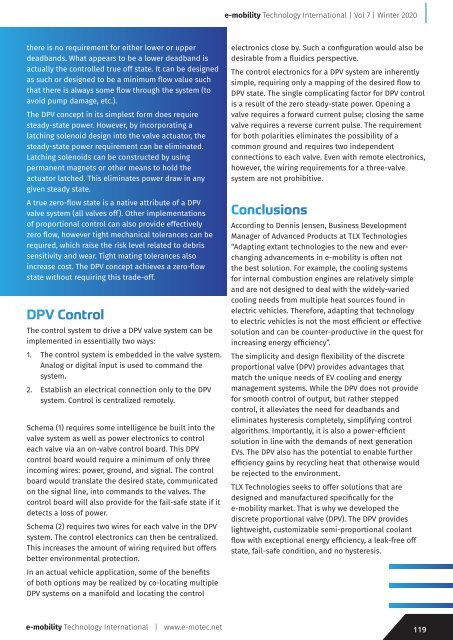E-mobility Technology Winter 2020
Electric vehicle technology news: Maintaining the flow of information for the e-mobility technology sector
Electric vehicle technology news: Maintaining the flow of information for the e-mobility technology sector
You also want an ePaper? Increase the reach of your titles
YUMPU automatically turns print PDFs into web optimized ePapers that Google loves.
e-<strong>mobility</strong> <strong>Technology</strong> International | Vol 7 | <strong>Winter</strong> <strong>2020</strong><br />
there is no requirement for either lower or upper<br />
deadbands. What appears to be a lower deadband is<br />
actually the controlled true off state. It can be designed<br />
as such or designed to be a minimum flow value such<br />
that there is always some flow through the system (to<br />
avoid pump damage, etc.).<br />
The DPV concept in its simplest form does require<br />
steady-state power. However, by incorporating a<br />
latching solenoid design into the valve actuator, the<br />
steady-state power requirement can be eliminated.<br />
Latching solenoids can be constructed by using<br />
permanent magnets or other means to hold the<br />
actuator latched. This eliminates power draw in any<br />
given steady state.<br />
A true zero-flow state is a native attribute of a DPV<br />
valve system (all valves off). Other implementations<br />
of proportional control can also provide effectively<br />
zero flow, however tight mechanical tolerances can be<br />
required, which raise the risk level related to debris<br />
sensitivity and wear. Tight mating tolerances also<br />
increase cost. The DPV concept achieves a zero-flow<br />
state without requiring this trade-off.<br />
DPV Control<br />
The control system to drive a DPV valve system can be<br />
implemented in essentially two ways:<br />
1. The control system is embedded in the valve system.<br />
Analog or digital input is used to command the<br />
system.<br />
2. Establish an electrical connection only to the DPV<br />
system. Control is centralized remotely.<br />
Schema (1) requires some intelligence be built into the<br />
valve system as well as power electronics to control<br />
each valve via an on-valve control board. This DPV<br />
control board would require a minimum of only three<br />
incoming wires: power, ground, and signal. The control<br />
board would translate the desired state, communicated<br />
on the signal line, into commands to the valves. The<br />
control board will also provide for the fail-safe state if it<br />
detects a loss of power.<br />
Schema (2) requires two wires for each valve in the DPV<br />
system. The control electronics can then be centralized.<br />
This increases the amount of wiring required but offers<br />
better environmental protection.<br />
In an actual vehicle application, some of the benefits<br />
of both options may be realized by co-locating multiple<br />
DPV systems on a manifold and locating the control<br />
electronics close by. Such a configuration would also be<br />
desirable from a fluidics perspective.<br />
The control electronics for a DPV system are inherently<br />
simple, requiring only a mapping of the desired flow to<br />
DPV state. The single complicating factor for DPV control<br />
is a result of the zero steady-state power. Opening a<br />
valve requires a forward current pulse; closing the same<br />
valve requires a reverse current pulse. The requirement<br />
for both polarities eliminates the possibility of a<br />
common ground and requires two independent<br />
connections to each valve. Even with remote electronics,<br />
however, the wiring requirements for a three-valve<br />
system are not prohibitive.<br />
Conclusions<br />
According to Dennis Jensen, Business Development<br />
Manager of Advanced Products at TLX Technologies<br />
“Adapting extant technologies to the new and everchanging<br />
advancements in e-<strong>mobility</strong> is often not<br />
the best solution. For example, the cooling systems<br />
for internal combustion engines are relatively simple<br />
and are not designed to deal with the widely-varied<br />
cooling needs from multiple heat sources found in<br />
electric vehicles. Therefore, adapting that technology<br />
to electric vehicles is not the most efficient or effective<br />
solution and can be counter-productive in the quest for<br />
increasing energy efficiency”.<br />
The simplicity and design flexibility of the discrete<br />
proportional valve (DPV) provides advantages that<br />
match the unique needs of EV cooling and energy<br />
management systems. While the DPV does not provide<br />
for smooth control of output, but rather stepped<br />
control, it alleviates the need for deadbands and<br />
eliminates hysteresis completely, simplifying control<br />
algorithms. Importantly, it is also a power-efficient<br />
solution in line with the demands of next generation<br />
EVs. The DPV also has the potential to enable further<br />
efficiency gains by recycling heat that otherwise would<br />
be rejected to the environment.<br />
TLX Technologies seeks to offer solutions that are<br />
designed and manufactured specifically for the<br />
e-<strong>mobility</strong> market. That is why we developed the<br />
discrete proportional valve (DPV). The DPV provides<br />
lightweight, customizable semi-proportional coolant<br />
flow with exceptional energy efficiency, a leak-free off<br />
state, fail-safe condition, and no hysteresis.<br />
e-<strong>mobility</strong> <strong>Technology</strong> International | www.e-motec.net<br />
119









